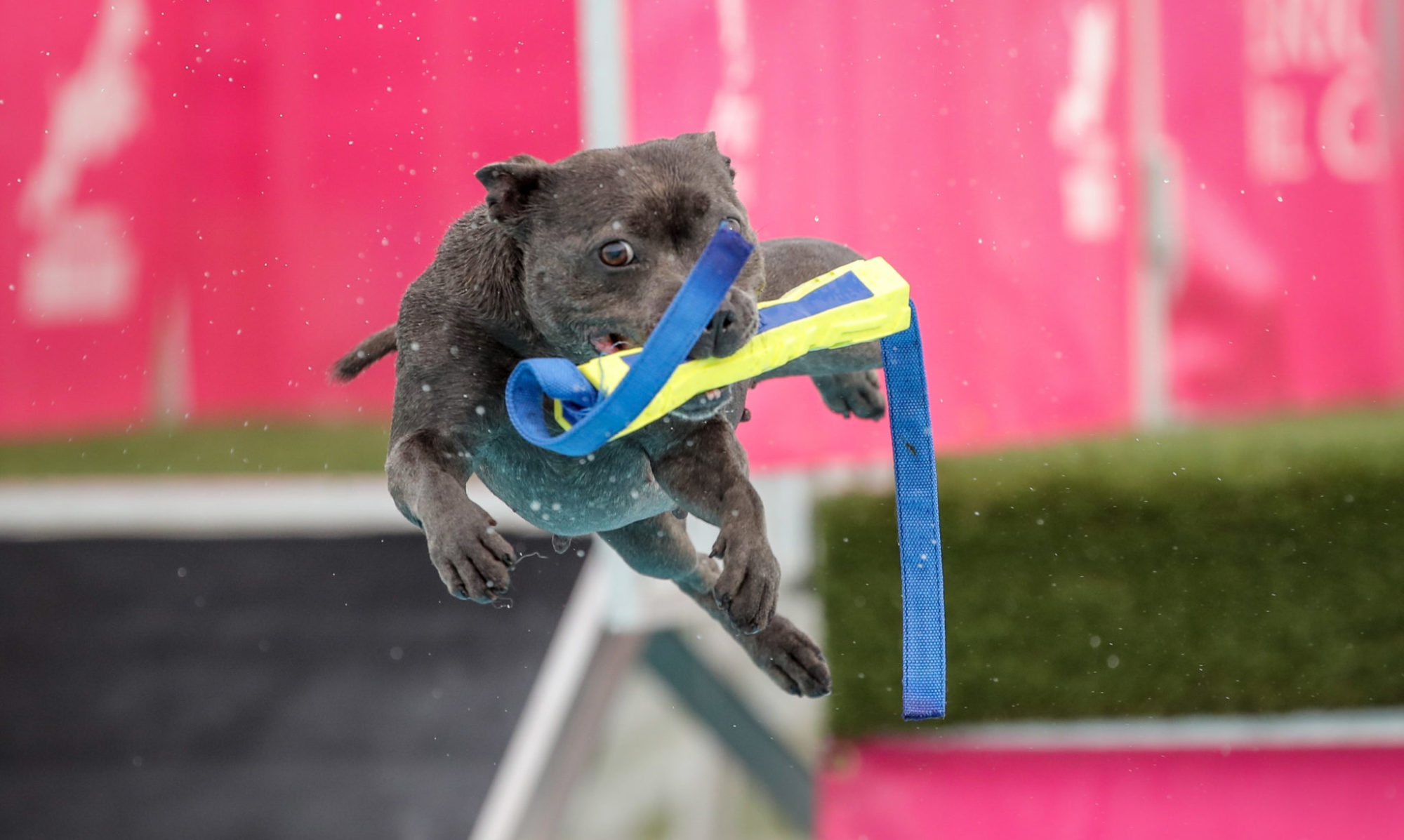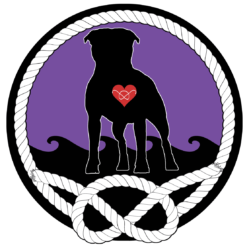







Wavemaker Staffords Breed Standard Discussion

Origins
Although there has been some discussion through the years about the origin of the Staffordshire Bull Terrier, authorities generally agree that the breed can be traced back to the Mastiff-like dogs through the old Bulldog which, when crossed with British terriers, produced the first “Bull and Terriers.” Books published in the early 1800s which refer to “Bull and Terriers,” “Pit Dogs”, and “Fighting Dogs” confirm that the cross existed at that time.
The old-fashioned Bulldog was a fierce, courageous animal used in the sports of bear- and bull-baiting as early as the mid-sixteenth century. When these sports fell from public favor and were outlawed, their supporters turned to dog fighting and sought to create a sporting dog that, while retaining the legendary courage and ferocity of the Bulldog, would incorporate the greater agility of the terrier.
Refinement
Terriers thought to have been used in the cross are the Manchester Terrier and the now-extinct English White Terrier. In addition, crosses with various of the old working terriers were made.
Because of the attentions of different groups of English fanciers, two distinct types of Bull and Terrier arose and, by 1900, they were easily distinguished. James Hinks’s elegant white dogs, produced by crossing the predecessor of the modern Bulldog with the English White Terrier (and some say Pointer and Dalmatian) were recognized by the Kennel Club (UK) and the American Kennel Club at the turn of the century. This “White Cavalier” is known today as the Bull Terrier.
The other Bull and Terrier — the Stafford, which was owned by the common man — was not as easily “legitimized.” Fanciers of the “working class dog” met in England in 1935 to form a club for the Staffordshire Bull Terrier fanciers and draw up a Breed Standard.
Recognition
In 1938, the first Championship points were awarded in Birmingham. The first two members of their sex to claim championships in England were the bitch, Lady Eve (see top of page right) and the dog, Gentleman Jim (see top of page left) in 1939.
The first Staffordshire Bull Terriers brought to the United States lived their lives out simply as companions; it was not until 1975 that The American Kennel Club recognized the Staffordshire Bull Terrier as a registerable breed that could be shown outside of the Miscellaneous Classes. The first Stafford to be registered in the American Kennel Club Stud Book was the English import, Ch. Tinkinswood Imperial. The first U.S. champion was a bitch, the Australian import, Northwark Becky Sharpe.
The Stafford is a well-kept secret: smart, healthy, rough and tumble, comfort-loving, and a family pet and chum without equal when properly trained and socialized. One of the best known terriers in The British Isles (where at least 15 Stafford clubs exist), it is also one of the ten most popular dogs in Australia and the most popular terrier in South Africa. In the U.S., it is often mistaken for its cousin, the American Pit Bull Terrier, which has established a greater foothold there.
The Staffofdshire Bull Terrier presents an incredible mix of intelligence, courage and tenacity tempered with a sweet affection for its family. As a breed it is often shrouded in myth and misconception about its history and origin. The origins of the Staffordshire Bull Terrier can be dated back to Elizabethan England. The Breed can also be linked to the early Mastiff like dogs along with the early Bulldog which, when crossed with the British terriers, produced the first “Bull and Terrier”(Pit dogs) cross in the British Isles.
The actual method of manufacture of this breed of dog is rather clouded. Suffice to say early crossings with the Bulldog and a small active Terrier took place over 150 years ago. The Old English Terrier an Extinct breed now but an important factor in the history of dogs. Not only did this tough little Terrier prove instrumental in production of the Staffordshire but he was progenitor of other indigenous breeds such as the Old English Black and Tan Terrier, later to be known as the Manchester Terrier. Some eight or nine varieties of dogs come within the general classification of Bull and Terrier. All lay claim to the Bulldog as a common ancestor, which when crossed with certain other breeds and developed by careful selection according to the use or fancy required of them, produces these different and distinct sorts. As to which Terrier was used in the union is indeterminate. All Bull and Terrier breeds descend from similar but separate varieties of “Bull and Terriers”(Pit dogs) produced from crosses between different types of British Terrier (Old English Terrier, White English Terrier, Manchester Terrier) and ancient Bulldogs. The stock which came from the union of the Bulldog and this Terrier(Old English Terrier) would have varied in extreme cases at maturity between 20 and 60 pounds weight, averaging no doubt between 30 and 45 pounds. This weight margin allowed a dog which was substantial, muscular and athletic. These attributes motivated with courage and tenacity produced fighting dogs for over 100 years and gave us the Staffordshire Bull Terrier. The offspring of these dogs were originally bred for participating in bull and bear baiting, boar hunting, dog fighting, ratting and badger hunting. Some believe that these dogs were also pitted against armed men. (Ancestors Staffordshire Bull Terrier)
These dogs were renowned for their courage and tenacity and despite their ferocity in the pit/ ring were excellent companions and good with children. In fact it was not unknown for an injured dog to be transported home in a pram with the baby. The Pit dog was a favorite with miners and steelworkers and was prevalent amongst the chainmakers of the “Black Country” where the dogs were not only fought for entertainment but provided a working man with valuable extra income when worked against badgers or as ratters. By 1800 because of the attentions of different groups of English fancier, two distinct types of the bull and terrier breed arose and by the early 1800’s they were easily distinguished. The Old Pit Bull Terrier, the dog we call the Staffordshire Bull Terrier today, gave us the all white English Bull Terrier. This was formed around the mid 1800’s in Birmingham. A cross of the original dog with the Old English White Terrier, now extinct and possible sundry other breeds predominantly white. One branch of the bull and terrier strain became today’s dapper, roman-nosed Bull Terrier and the other became the smaller, stockier, Stafford “working class” was baptized as the Staffordshire Bull Terrier. Many crosses were recognized by the Kennel Club(England) and the American Kennel Club at the turn of the century. One Bull and Terrier(the Stafford), which was owned by the common man was not as easily “legitimized”. With the introduction of the Humane Act in 1835, baiting sports and dog fighting became unlawful and a small group of men in the Staffordshire area endeavored to preserve their breed by introducing them to the dog show world.
In 1935, fanciers of the “working class dog” met in England to form the Staffordshire Bull Terrier club and write a standard to differentiate him from the other Bull and Terriers.
In 1938 the first Championship points were awarded in Birmingham, England. The first Staffordshire Bull Terriers that were taken to the United States lived there as companion dogs. The breed was recognized by the AKC in 1975. Todays Staffordshire Bull Terrier is a very popular family pet and show dog in the British Isles, South Africa and Australia, as well as in the United States. Staffords have become known for their excellent nature with children and are one of the two dogs named as Nanny Dogs.
Breed History
6/30/06
excerpt from www.sbtca.com and books recognized in the ‘book’ link
on this website







Copyright 2003-2017 by Wavemaker Staffords.
WARNING ! All content contained within this site is protected by copyright laws.
Unauthorized use of our material is strictly prohibited. Please ask for permission if interested in usage.
Play nice, we share.

